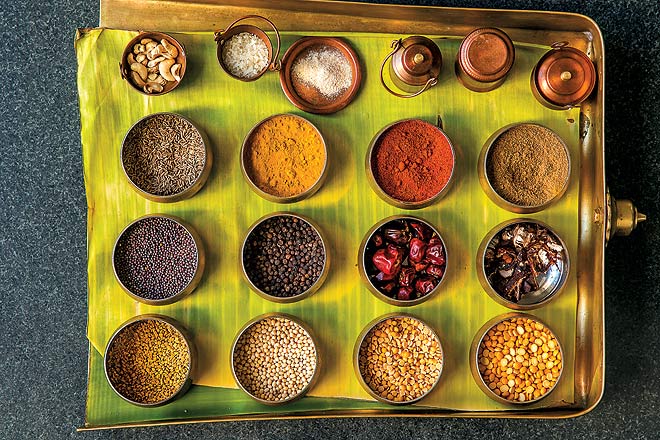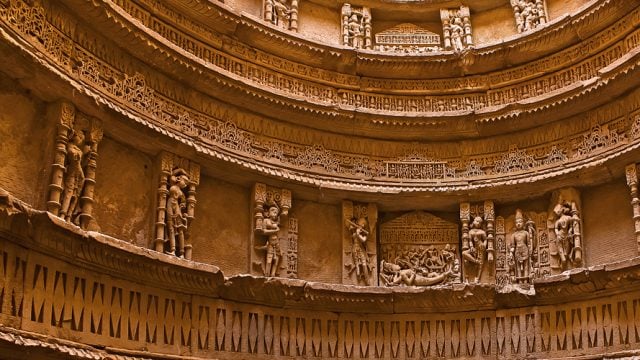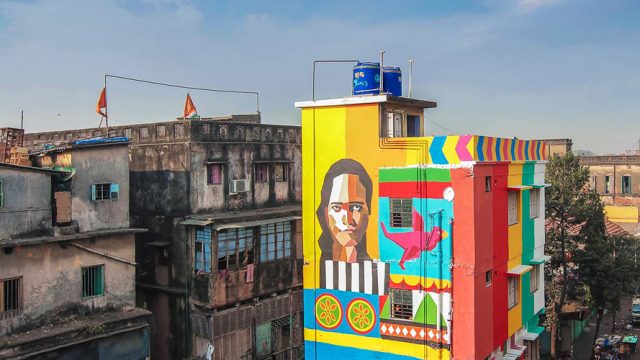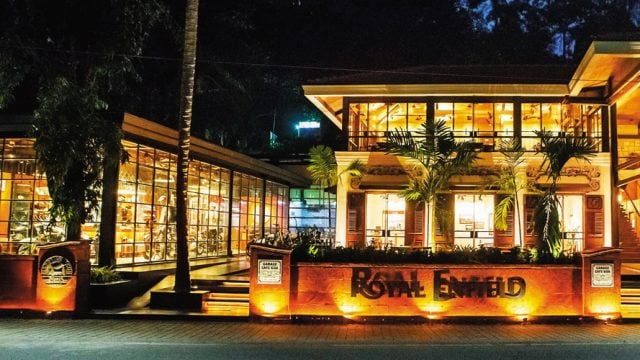It all began with a dream about coffee. Davarah-tumbler, a rich brown liquid, quite sweet, slightly bitter,
Vaibhav and I had been walking around Thanjavur’s main market for half an hour. We had made frequent stops. I, distracted by a compulsion to buy little bits off the piles of gundu milagu and vatthal as well as by the dazzling white smiles of women who closed their mouths only long enough to frame giggling replies to my pidgin Tamil. Vaibhav, intent on his photographic duties.

“Kaapi kadai engey, please?”, “Ingey daan, ma!”, “Anda roadle, kadaseele, ma!”, and so it went, from street to little street. Till we turned a corner and there it was: Coffee Palace, Kasi Kadai Street. My dream was not a dream but a memory, the sight shot with that same joyful blue, the coffee exactly as I thought I had dreamt it. We had two servings each and stopped only because we were a bit dizzy with the perfection of the moment. We had only met the day before, but Vaibhav was just as overcome as I and we nearly hugged in happiness.
This is what suddenly finding oneself at the centre of one’s universe can do to an otherwise reasonably rational, not overly sentimental, currently only moderately greedy person. I am not particularly interested in tourists’ fantasies but since it has been said before, I may as well say it again: if there’s one place in Tamil Nadu that you must visit before you die, it is Thanjavur. This is the heart of Tamil culture, a musical place fed by gently thrumming arteries with names just as mellifluous, if your tongue can wrap itself around the several syllables correctly: Thiruvaiyaru, Kumbakonam, Darasuram, Papanasam, Swamimalai, Gangaikondacholapuram…
My previous visit to Thanjavur, many years ago and the same one that had fed my dream, was a very different one. I had set off from Chennai in a non-AC Maruti van, whose surly driver had insisted on playing on loop a Tamil film song trendy at the time, as we rattled around Tamil Nadu on the ‘Chola temple circuit’. On this first romantic encounter with the Tamil heartland, I had stayed at TTDC’s Hotel Tamilnadu in Thanjavur, but I was even nearly charmed by the cockroaches scurrying into the tears of the raggedy coir ‘carpet’. This time, like I said, it’s different. Very different.
And that’s because I’m staying at the resplendent Svatma, Thanjavur’s first bona fide luxury hotel. The kind of place where elegant staff drapes an angavastram around you, garlands you with mallipu and coaxes cool coconut water down your throat before you’re across the thinnai. I had arrived in style too, off a flight to Trichy and then driven in an SUV along an excellent road to the hotel.

Krithika Subrahmanian had been on the same flight from Chennai. Architect, Bharatanatyam dancer, fierce health-freak (“I never eat anything out of a packet. Except ice cream”), this wonderwoman is the raison d’etre for Svatma. Married into a family that made its wealth in the building business, she is the epitome of TamBrahm gentility—and business commonsense. It beggars belief that no one in the industry had thus far grabbed the opportunity to provide a commodious luxury base for tourism in this region. (Till recently, the closest the luxury traveller got to accessing the Chola heartland in comfort was in Chettinad; Thanjavur’s only other boutique hotel is just that, boutique i.e. small and unable to accommodate largeish groups.)
Subrahmanian has restored a century-old traditional mansion (which now houses an open-to-air café, an assortment of banquet areas and, on the upper floors, the seven ‘heritage’ rooms) and also built an adjoining structure that of fers another 31. Though Svatma likes to describe all the rooms as ‘heritage’, those in the new ‘millennium’ wing are fairly standard-issue five-star rooms, albeit with local colour in the form of fat-figured Nayak art and nice touches such as a pocket Bhagavad Gita by Annie Besant on every bedside table. The rooms in the old wing are downright gorgeous, though, with antique furniture and custom-woven rugs and throws in brilliant Tamil colours. A couple have private balconies that look on to the beautiful old tree that frames the façade of the building. If you’ve got money to throw, make sure you send it down this particular chute.
After a dozen years and counting at OT, I’ve seen a fair number of luxury hotels. And yes, there exists the phenomenon called too-much-of-a-good-thing. So my eye tends to glaze over these days at the power showers and the espresso machines and the pillow menus. And brightens at any display of, to use that coy phrase, ‘a special something’. The last thing I had expected was that it would arrive on a platter. (I was mildly sulky about the fact that I would have to go vegetarian for my three days at Svatma.) But the food here is a revelation: Tanjore Maratha food! Do you know it? I didn’t.
Any guidebook will tell you about the diverse heritage of this storied city—its being ruled consecutively by those great monument-builders, the Cholas, then the Pandyas, the Nayaks and the Marathas, who finally gave over to the British (“four dynosities”, as Mr Raja, Tourist Guide, told us at the Thanjavur Palace, but I’ll return to him shortly). But, apart from the built heritage—most notably in the form of the stupendous 11th-century Brihadisvara temple (Chola) and the Thanjavur Palace (Nayak and Maratha)—there’s little immediate evidence to the visitor of that diverse culture.

So it is with considerable gratitude that I receive a gleaming brass thali at Svatma. Multiple bowls contain a variety of unfamiliar foods and Arun Kumar, F&B manager, is happy to rattle off the names: Ambat Rasa (“spicy Indian curry with yam stick, onion and 15 secret spices”), Udidal Saakla (“boiled black gram with onion and tomato”), Ambat Bindiya (“okra tossed with Indian spices”) and my favourite Kaccha Pulicha (“uncooked tamarind extract with onion and coriander”). The last looks like a rasam and feels like a rasam but isn’t a rasam; if it’s possible to better a rasam in idea and expression, this is it. Thin, light, cooling, incredibly appetising. Thanjavur is famous for being the source of refined Brahmin vegetarian food—and it is possible to eat well elsewhere in town—but not a trace of this fascinating Maratha culinary legacy has been seen thus far, not for love or money.
And now you can; for money, of course. Even if you’re not staying at Svatma, do drop in for lunch. Subrahmanian and her able cohort, Francophone food consultant JK Madan, spent months searching out Maratha families still extant in Thanjavur and persuaded some of the ladies out of their own kitchens and into Svatma’s. The result is a sensory delight and an important documentary exercise.

A meal at Svatma is only about the fourth and newest ‘thing to do’ in Thanjavur. For those who share my depth of romantic affection for the city, two weeks every year of one’s life may suffice. But for most tourists, two days here once in their lives seems to be plenty, enough to ‘do’: 1) the Brihadisvara, 2) the Thanjavur Palace and 3) buy a Tanjore painting or silk sari. But here too is another advantage of staying at the Svatma. Their ‘experience modules’ range from culinary classes, to witnessing bronze-casting demos or Vedic chanting by priests or a Bharatanatyam recital of the ‘Thanjavur school’ or a chamber concert of the veena, to visiting handloom weavers or Tanjore painting artisans, to a trip to the Big Temple with an ‘academic expert’. Vaibhav and I sat in on the music and dance sessions, arranged for the edification of a bunch of somewhat puzzled Westerners, and decided to strike out on our own for the rest.
Thus do we encounter another highlight: Mr Raja, Tourist Guide. Anyone who has availed of the services of this category of professionals in India will have their own charming experiences to relate. I too have met a few but Raja is special. First, he delights me and confounds Vaibhav by proclaiming loudly, “Wybow! What a name! The great Lord Vishnu!” And then, at the art gallery in the Thanjavur Palace, with its priceless collection of massive antique Nataraja bronzes, pleases Vaibhav too, by striking a series of tandava poses, excellently balanced given his apparent decrepitude.
We had arranged to meet at the Periya Koil or Big Temple at 6am the next day. It seemed entirely in keeping with his happy whimsical character that Raja stood us up. Which left Wybow and I unlectured and unentertained, and a good thing too. Because it is correct to submit to the grand edifice with solemnity and awe. I am content to gaze quietly at the gopuram, do an irreligious but deeply respectful couple of parikramas and watch the worshippers. They are here in droves, the spillover from neighbouring Kumbakonam, where the massive Mahamaham has just concluded.

And then we meet another Raja. A real one. At least, he would have been, if that thing called the sovereign democratic republic of India hadn’t got in the way. His card reads “Ry. B. Sambaji Rajah Bhonsle” and he and his brothers live in one wing of the Thanjavur Palace, not quite in the manner of their ancestors a century and a half ago. Mr Bhonsle has some English and his brother, busy at his little desk putting the finishing touches to a painting, has none. They are both extremely gracious though and display painting after painting stacked casually against peeling walls in dark, musty, low-ceilinged rooms. This is how the family makes a living, selling these coveted artefacts for as little as three thousand rupees for a small Tanjore painting to lakhs for one vast and intricate piece. It’s a touching encounter, a conversation conducted largely through gesture and smile, and somehow fitting of dispossessed royalty in spite of the modest environment.
I bow my way out of the short door with regret. I breathe a sigh for a lost time, when the great Thyagaraja shaped Carnatic music on the banks of the Kaveri nearby, when that other fascinating local, Balasaraswati, brought Bharatanatyam to the world stage. But there’s still grace to be found here, as Mr Bhonsle showed me. I could live with a leader like this, in times like these, in a town like this.
The information
Getting there: The closest airport is Trichy (50km/45min). Jet Airways flies thrice a day to and from Chennai (from approx â?¹2,500 one way). Madurai airport is 2hrs away. Thanjavur also has a railway station, connected to Chennai and other cities in Tamil Nadu.
Where to stay: The newest and most luxurious hotel in town is Svatma (‘millennium rooms’ from â?¹10,000; ‘heritage rooms’ from â?¹12,000; with breakfast, taxes extra; www.svatma.in). Tanjore Hi has 14 trendy rooms (from â?¹5,500; www.duneecogroup.com). Reliable but unexciting midrange options include Hotel Parisutham (from â?¹4,000; www.hotelparisutham.com), Hotel Sangam (from â?¹4,700; www.sangamhotels.com) and Hotel Gnanam (from â?¹3,100; www.hotelgnanam.com). And yes, there’s Hotel Tamilnadu (from â?¹1,400; www.ttdconline.com).
Where to eat: Svatma, for refined Tamil vegetarian food and, if you visit on the right day, exciting Maratha-Tamil food. Eat satisfyingly off a banana leaf at Sri Venkata Lodge on Gandhiji Road. Thevar’s, also on Gandhiji Road, does a good chicken biryani. Gnanam and Sangam also have restaurants that dish out palatable fare.
What to see & do:
Visit the Brihadisvara: This is why you’re here. Go early, to wander the vast courtyard in peace and get the best light for your pics.
Spend an hour or two at the Thanjavur Palace: Recently renovated (in questionable taste), the art gallery has a jaw-dropping collection of bronzes, one large room of which is given over entirely to massive antique Natarajas. The Palace also houses the Saraswathi Mahal Library, also recently renovated, with a staggering collection of old Sanskrit manuscripts and colonial texts.
Get an appointment with the Bhonsle family and watch respectfully as a Tanjore painting is brought to life (04362-273127, [email protected]). Buy one too.
Visit a handloom weaver and be introduced to another Thanjavur speciality, the korvai interlocking system of border-weaving. The family of SV Rajaratinam is welcoming, articulate and also have a small collection of gorgeous saris for sale (SR Vishwanath, 9367722266, [email protected]).
Go in January for the Thyagaraja Aradhanai, one of the biggest Carnatic music festivals, held annually in Thiruvaiyaru (13km) to commemorate the saint’s birth anniversary. Hundreds of musicians turn up for this massive enchanting display.
Look out for when the Festival of Sacred Music will be held (usually in February). This relatively new event, held over a few days at various atmospheric venues in Thiruvaiyaru, brings Carnatic, Hindustani and World music to these parts, to the delight of music-mad locals. See festivalofsacredmusic.com.
Bharatnatyam
Brihadisvara Temple
Chennai





